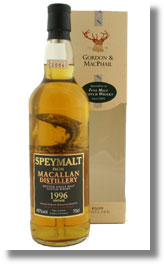Norwegian Scotch Malt Whisky Society
Main menu:
Meeting No. 103
Meetings > Minutes > 2009
The 103rd Meeting of the Norwegian Scotch Malt Whisky Society was held at Aroma Bar on March 27, 2009.
Members present
- Springbank
- Ms. Rayyan
- Sigve
- Ms. Jansen
- Mr. Gjøen
- Mr. Kjepso
- Ms. Raa
- The Laird
- Mr. Endre Hole
- Butt
- Mr. Eirik Hole
- Mr. Rå
Whisky of the Night
Speymalt
- Speyside
- Single malt
- MacAllan Destillery (1997)
- 40% (vol)
Guest(s)
- Gunnar
Members meeting #103
Tonight's host, Springbank, held a speech telling about the 6 main components to establish whisky flavour and aroma, namely, water, barley, yeast, climate, stills and wood (below).
He further gave an introduction to the whisky of the night. Other whiskies included:
- Ledaig Single Malt, Tobermory Destillery. Isle of Mull. 42% alc.
- Glen Moray, 8yrs, Speyside. 40% alc.
It was decided that the strictly educational trip to Islay will be at next year's spring. Marianne made offensive comments about the honorable members of NSMWS and called us "berme". She's hereby back on trial membership...
Next meeting will include a blind tasting. Details will follow by e-mail to the members.of script.
Synopsis written by Mr. Rå
Water
Whether from stream, spring or well, a pure, reliable water source is vital to whisky production. The character of the water will depend on the source and the terrain the water passes over - peat, granite, etc.
Barley
Each distiller has his own preference to the type of barley used. In the past, Golden Promise was the most commonly used. However, experiments have been carried out to give the farmers varieties with higher yields and the distillers higher amounts of fermentable sugars.Varieties such as Prisma and Chariots are now widely used.
Yeast
Again distillers have their own favourites. However, in general, two types of yeast are used in the fermentation process - distiller's yeast and brewer's yeast. While both convert the sugars present in the wort into alcohol, the brewer's yeast is used to add flavour during this reaction.
Climate
During maturation the casks will expand during the hotter summer months and then contract during winter. They breathe in the surrounding air, evident in the Island whiskies or whiskies matured near the sea where salty, briny flavours are noted. Maturation in a hot and dry environment, such as in Bourbon in America, will cause a higher loss of water through evaporation and a consequent gain in the spirit strength. This increase will cause different reactions with the wood and so cause different flavours to be produced. With damp conditions and a loss of alcohol these reactions will lessen and the spirit will slowly mature, extracting the tannins and other chemicals in the wood.
Stills
The shape of the still is very important to the final product. We hear stories that when stills have to be replaced they are copied exactly - including any bumps or dents. Tall-necked stills tend to produce a finer, lighter spirit due to the vapours condensing before reaching the end of the Lyne arm and falling back into the distillate to be redistilled. Shorter stills will produce a fuller, richer spirit. As well as the numerous shapes and sizes of stills, there are various other factors that can be introduced to affect the spirit. The Lyne can be positioned slightly upwards, again causing the vapours to condense and trickle back to be redistilled. A rectifier or purifier can be placed on the Lyne arm. This is a box with cool coils running through it and as the vapours hit these coils they condense and are returned to the distillate.
Wood
As already mentioned, whisky is matured in oak casks. This oak may have been used to mature sherry or bourbon or it may be plain oak - a cask already used several times to mature whisky. During maturation reactions take place between the spirit and the wood. The spirit will also extract components from the wood such as tannins, vanillin (a sweet, vanilla flavour) as well as the sherry or bourbon. Once a cask has been used several times its ability to mature whisky lessens. It can be rejuvenated by burning the inside and then removing the burnt wood. This process known as charring causes some of the wood extracts such as vanillin to be released.
